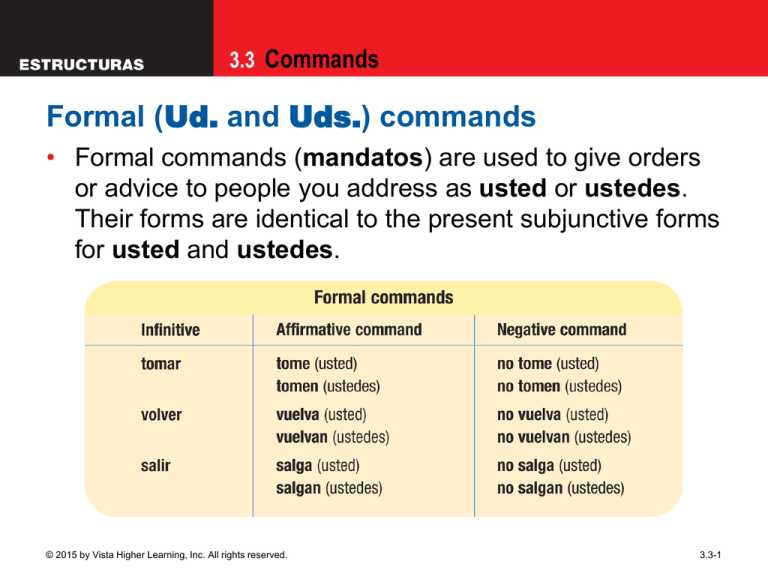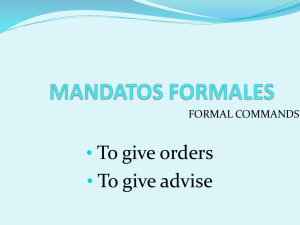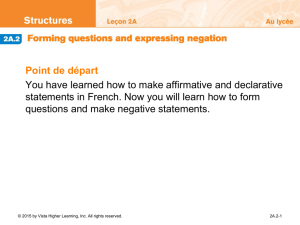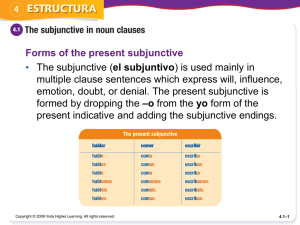
3.3 Commands
Formal (Ud. and Uds.) commands
• Formal commands (mandatos) are used to give orders
or advice to people you address as usted or ustedes.
Their forms are identical to the present subjunctive forms
for usted and ustedes.
© 2015 by Vista Higher Learning, Inc. All rights reserved.
3.3-1
3.3 Commands
Familiar (tú) commands
• Familar commands are used with people you address as
tú. Affirmative tú commands have the same form as the
él, ella, and usted form of the present indicative.
Negative tú commands have the same form as the tú
form of the present subjunctive.
© 2015 by Vista Higher Learning, Inc. All rights reserved.
3.3-2
3.3 Commands
¡ATENCIÓN!
Vosotros/as commands
In Latin America, ustedes commands serve
as the plural of familiar (tú) commands. The
familiar plural vosotros/as command is used
in Spain. The affirmative command is formed
by changing the –r of the infinitive to –d. The
negative command is identical to the
vosotros/as form of the present subjunctive.
bailar: bailad/no bailéis
—Toma, ponte esto.
For reflexive verbs, affirmative commands are
formed by dropping the –r and adding the
reflexive pronoun –os. In negative
commands, the pronoun precedes the verb.
levantarse: levantaos/no os levantéis
Irse is irregular: idos/no os vayáis
© 2015 by Vista Higher Learning, Inc. All rights reserved.
3.3-3
3.3 Commands
• Eight verbs have irregular affirmative tú commands.
Their negative forms are still the same as the tú form of
the present subjunctive.
decir
di
salir
sal
hacer
haz
ser
sé
ir
ve
tener
ten
poner
pon
venir
ven
© 2015 by Vista Higher Learning, Inc. All rights reserved.
3.3-4
3.3 Commands
Nosotros/as commands
• Nosotros/as commands are used to give orders or
suggestions that include yourself as well as others. They
correspond to the English let’s + [verb]. Affirmative and
negative nosotros/as commands are generally identical
to the nosotros/as forms of the present subjunctive.
© 2015 by Vista Higher Learning, Inc. All rights reserved.
3.3-5
3.3 Commands
• The verb ir has two possible affirmative nosotros/as
commands: vayamos, the form identical to that of the
present subjunctive, and the more common vamos. In
the negative, however, use only no vayamos.
© 2015 by Vista Higher Learning, Inc. All rights reserved.
3.3-6
3.3 Commands
Using pronouns with commands
• When object and reflexive pronouns are used with
affirmative commands, they are always attached to the
verb. When used with negative commands, the pronouns
appear between no and the verb.
Levántense temprano.
No se levanten temprano.
Wake up early.
Don’t wake up early.
Dímelo todo.
No me lo digas.
Tell me everything.
Don’t tell it to me.
© 2015 by Vista Higher Learning, Inc. All rights reserved.
3.3-7
3.3 Commands
¡ATENCIÓN!
When one or more pronouns are attached to an affirmative
command, an accent mark may be necessary to maintain the
command form’s original stress. This usually happens when the
combined verb form has three or more syllables.
decir:
di, dile, dímelo
diga, dígale, dígaselo
digamos, digámosle, digámoselo
© 2015 by Vista Higher Learning, Inc. All rights reserved.
3.3-8
3.3 Commands
• When the pronouns nos or se are attached to an
affirmative nosotros/as command, the final s of the
command form is dropped.
Sentémonos aquí.
No nos sentemos aquí.
Let’s sit here.
Let’s not sit here.
Démoselo mañana.
No se lo demos mañana.
Let’s give it to him
tomorrow.
Let’s not give it to him
tomorrow.
© 2015 by Vista Higher Learning, Inc. All rights reserved.
3.3-9
3.3 Commands
Indirect (él, ella, ellos, ellas) commands
• The construction que + [subjunctive] can be used with a
third-person form to express indirect commands that
correspond to the English let someone do something. If
the subject of the indirect command is expressed, it
usually follows the verb.
Que pase el siguiente.
Que lo haga ella.
Let the next person pass.
Let her do it.
© 2015 by Vista Higher Learning, Inc. All rights reserved.
3.3-10
3.3 Commands
• Unlike with direct commands, pronouns are never
attached to the conjugated verb.
Que se lo den los otros.
Que no se lo den.
Que lo vuelvan a hacer.
Que no lo vuelvan a hacer.
© 2015 by Vista Higher Learning, Inc. All rights reserved.
3.3-11









